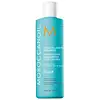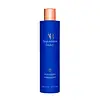What's inside
What's inside
 Key Ingredients
Key Ingredients

 Benefits
Benefits

 Concerns
Concerns

 Ingredients Side-by-side
Ingredients Side-by-side

Water
Skin ConditioningSodium C14-16 Olefin Sulfonate
CleansingCocamidopropyl Betaine
CleansingCocamide Methyl Mea
Dipropylene Glycol
HumectantLauryl Hydroxysultaine
CleansingTea-Cocoyl Glutamate
CleansingPolysorbate 20
EmulsifyingArgania Spinosa Kernel Oil
EmollientFumaria Officinalis Extract
Skin ConditioningHordeum Distichon Extract
Skin ProtectingMelissa Officinalis Leaf Extract
Skin ConditioningPrunus Yedoensis Leaf Extract
Skin ConditioningSwertia Japonica Extract
Skin ConditioningMenthol
MaskingCitric Acid
BufferingDipotassium Glycyrrhizate
HumectantGlucosyl Hesperidin
HumectantNiacinamide
SmoothingEthylhexylglycerin
Skin ConditioningPEG-160 Sorbitan Triisostearate
CleansingPolyquaternium-10
Salicylic Acid
MaskingButylene Glycol
HumectantIsopropyl Alcohol
SolventParfum
MaskingDisodium EDTA
Sodium Acetate
BufferingSodium Benzoate
MaskingSodium Citrate
BufferingSodium Dilauramidoglutamide Lysine
HumectantPhenoxyethanol
PreservativeLinalool
PerfumingLimonene
PerfumingWater, Sodium C14-16 Olefin Sulfonate, Cocamidopropyl Betaine, Cocamide Methyl Mea, Dipropylene Glycol, Lauryl Hydroxysultaine, Tea-Cocoyl Glutamate, Polysorbate 20, Argania Spinosa Kernel Oil, Fumaria Officinalis Extract, Hordeum Distichon Extract, Melissa Officinalis Leaf Extract, Prunus Yedoensis Leaf Extract, Swertia Japonica Extract, Menthol, Citric Acid, Dipotassium Glycyrrhizate, Glucosyl Hesperidin, Niacinamide, Ethylhexylglycerin, PEG-160 Sorbitan Triisostearate, Polyquaternium-10, Salicylic Acid, Butylene Glycol, Isopropyl Alcohol, Parfum, Disodium EDTA, Sodium Acetate, Sodium Benzoate, Sodium Citrate, Sodium Dilauramidoglutamide Lysine, Phenoxyethanol, Linalool, Limonene
Water
Skin ConditioningSodium Cocoyl Isethionate
CleansingSodium Lauryl Sulfoacetate
CleansingCoco-Betaine
CleansingBrassicamidopropyl Dimethylamine
Skin ConditioningPropanediol
SolventHydroxypropyl Starch Phosphate
Cetyl Stearate
EmollientCitric Acid
BufferingHydroxyacetophenone
AntioxidantMaltooligosyl Glucoside
Skin ConditioningSodium Benzoate
MaskingCetyl Alcohol
EmollientHydroxypropyl Guar Hydroxypropyltrimonium Chloride
Isostearyl Isostearate
EmollientPotassium Cetyl Phosphate
EmulsifyingHydrogenated Starch Hydrolysate
HumectantPotassium Sorbate
PreservativeGlycerin
HumectantAdansonia Digitata Seed Oil
EmollientAvena Sativa Kernel Oil
Skin ConditioningO-Cymen-5-Ol
AntimicrobialPunica Granatum Seed Oil
EmollientPelargonium Graveolens Flower Oil
MaskingStearic Acid
CleansingAvena Strigosa Seed Extract
Skin ConditioningLecithin
EmollientRosa Damascena Extract
MaskingHydrolyzed Wheat Protein
Skin ConditioningMaltodextrin
AbsorbentNiacinamide
SmoothingAcetyl Tyrosine
Skin ConditioningAdenosine
Skin ConditioningArginine
MaskingHelianthus Annuus Seed Oil
EmollientLysine
Skin ConditioningMoringa Oleifera Seed Oil
EmollientOrnithine
Skin ConditioningPanax Ginseng Root Extract
EmollientProline
Skin ConditioningSodium Hydroxide
BufferingTocopherol
AntioxidantXanthan Gum
EmulsifyingBrassica Alba Seed Extract
Skin ConditioningHydrogenated Lecithin
EmulsifyingOligopeptide-177
Oligopeptide-6
Skin ConditioningSodium Chloride
MaskingCitronellol
PerfumingGeraniol
PerfumingWater, Sodium Cocoyl Isethionate, Sodium Lauryl Sulfoacetate, Coco-Betaine, Brassicamidopropyl Dimethylamine, Propanediol, Hydroxypropyl Starch Phosphate, Cetyl Stearate, Citric Acid, Hydroxyacetophenone, Maltooligosyl Glucoside, Sodium Benzoate, Cetyl Alcohol, Hydroxypropyl Guar Hydroxypropyltrimonium Chloride, Isostearyl Isostearate, Potassium Cetyl Phosphate, Hydrogenated Starch Hydrolysate, Potassium Sorbate, Glycerin, Adansonia Digitata Seed Oil, Avena Sativa Kernel Oil, O-Cymen-5-Ol, Punica Granatum Seed Oil, Pelargonium Graveolens Flower Oil, Stearic Acid, Avena Strigosa Seed Extract, Lecithin, Rosa Damascena Extract, Hydrolyzed Wheat Protein, Maltodextrin, Niacinamide, Acetyl Tyrosine, Adenosine, Arginine, Helianthus Annuus Seed Oil, Lysine, Moringa Oleifera Seed Oil, Ornithine, Panax Ginseng Root Extract, Proline, Sodium Hydroxide, Tocopherol, Xanthan Gum, Brassica Alba Seed Extract, Hydrogenated Lecithin, Oligopeptide-177, Oligopeptide-6, Sodium Chloride, Citronellol, Geraniol
Alternatives
Ingredients Explained
These ingredients are found in both products.
Ingredients higher up in an ingredient list are typically present in a larger amount.
Citric Acid is an alpha hydroxy acid (AHA) naturally found in citrus fruits like oranges, lemons, and limes.
Like other AHAs, citric acid can exfoliate skin by breaking down the bonds that hold dead skin cells together. This helps reveal smoother and brighter skin underneath.
However, this exfoliating effect only happens at high concentrations (20%) which can be hard to find in cosmetic products.
Due to this, citric acid is usually included in small amounts as a pH adjuster. This helps keep products slightly more acidic and compatible with skin's natural pH.
In skincare formulas, citric acid can:
While it can provide some skin benefits, research shows lactic acid and glycolic acid are generally more effective and less irritating exfoliants.
Most citric acid used in skincare today is made by fermenting sugars (usually from molasses). This synthetic version is identical to the natural citrus form but easier to stabilize and use in formulations.
Read more about some other popular AHA's here:
Learn more about Citric AcidNiacinamide is a multitasking form of vitamin B3 that strengthens the skin barrier, reduces pores and dark spots, regulates oil, and improves signs of aging.
And the best part? It's gentle and well-tolerated by most skin types, including sensitive and reactive skin.
You might have heard of "niacin flush", or the reddening of skin that causes itchiness. Niacinamide has not been found to cause this.
In very rare cases, some individuals may not be able to tolerate niacinamide at all or experience an allergic reaction to it.
If you are experiencing flaking, irritation, and dryness with this ingredient, be sure to double check all your products as this ingredient can be found in all categories of skincare.
When incorporating niacinamide into your routine, look out for concentration amounts. Typically, 5% niacinamide provides benefits such as fading dark spots. However, if you have sensitive skin, it is better to begin with a smaller concentration.
When you apply niacinamide to your skin, your body converts it into nicotinamide adenine dinucleotide (NAD). NAD is an essential coenzyme that is already found in your cells as "fuel" and powers countless biological processes.
In your skin, NAD helps repair cell damage, produce new healthy cells, support collagen production, strengthen the skin barrier, and fight environmental stressors (like UV and pollution).
Our natural NAD levels start to decline with age, leading to slower skin repair, visible aging, and a weaker skin barrier. By providing your skin niacinamide, you're recharging your skin's NAD levels. This leads to stronger, healthier, and younger looking skin.
Another name for vitamin B3 is nicotinamide. This vitamin is water-soluble and our bodies don't store it. We obtain Vitamin B3 from either food or skincare. Meat, fish, wheat, yeast, and leafy greens contain vitamin B3.
The type of niacinamide used in skincare is synthetically created.
Learn more about NiacinamideSodium Benzoate is a preservative. It's used in both cosmetic and food products to inhibit the growth of mold and bacteria. It is typically produced synthetically.
Both the US FDA and EU Health Committee have approved the use of sodium benzoate. In the US, levels of 0.1% (of the total product) are allowed.
Sodium benzoate works as a preservative by inhibiting the growth of bacteria inside of cells. It prevents the cell from fermenting a type of sugar using an enzyme called phosphofructokinase.
It is the salt of benzoic acid. Foods containing sodium benzoate include soda, salad dressings, condiments, fruit juices, wines, and snack foods.
Studies for using ascorbic acid and sodium benzoate in cosmetics are lacking, especially in skincare routines with multiple steps.
We always recommend speaking with a professional, such as a dermatologist, if you have any concerns.
Learn more about Sodium BenzoateWater. It's the most common cosmetic ingredient of all. You'll usually see it at the top of ingredient lists, meaning that it makes up the largest part of the product.
So why is it so popular? Water most often acts as a solvent - this means that it helps dissolve other ingredients into the formulation.
You'll also recognize water as that liquid we all need to stay alive. If you see this, drink a glass of water. Stay hydrated!
Learn more about Water